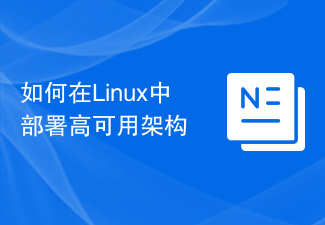 Backend Development
Backend Development Golang
Golang Practical skills: Use Go language to build a highly available CDN system
Practical skills: Use Go language to build a highly available CDN systemTo build a highly available CDN system, choosing the appropriate technology stack is very critical. In recent years, with the popularity of Go language, more and more developers choose to use Go language to build high-concurrency and high-reliability services. This article will introduce practical techniques for building a highly available CDN system using Go language.
1. Choose the appropriate framework
When using Go language to develop a CDN system, it is very important to choose the appropriate framework. Currently, the more mature Go language web frameworks include gin, beego, echo, etc., all of which provide good performance and scalability. When choosing a framework, you need to consider the following factors:
1. Performance: Choose a framework with better performance to ensure that the system has better response speed and processing capabilities.
2. Scalability: Choose a framework that is easy to expand to ensure that the system can quickly respond to business needs.
Here, we choose gin as the development framework. gin is a lightweight web framework with excellent performance and ease of use.
2. Use caching to improve performance
The core of the CDN system is the processing of static resources, and the processing of static resources is essentially the reading of files. To improve the performance of file access, we use caching to speed up file access. When a file is accessed, the cache is first queried. If the file exists in the cache, it is returned directly to the user. Otherwise, the corresponding file on the disk is queried and the file is cached in memory so that the cached data can be returned directly the next time the file is accessed. .
Go language provides a memory cache library that can quickly cache data into memory and improve the speed of data access. There are many choices for memory cache libraries, such as sync.Map, map, redis, etc. Here, we choose to use map to implement memory caching, because map has high performance and is relatively simple and easy to use.
3. Use asynchronous I/O to improve concurrency capabilities
The CDN system needs to handle a large number of requests at the same time, so concurrency capabilities are very important. Asynchronous I/O is an important way to improve concurrency capabilities. Go language inherently supports coroutines and asynchronous programming, which can easily solve high concurrency problems.
We can use Goroutine to implement asynchronous I/O so that the main thread will not be blocked when processing requests, thereby obtaining better concurrency performance. At the same time, when processing requests, we can also use channels to control the number of Goroutines to avoid too many coroutines occupying system resources.
4. Use load balancing to improve availability
The CDN system needs to have good availability and reliability. Therefore, the issue of load balancing should be considered during architecture design. The purpose of load balancing is to distribute requests to multiple servers in order to achieve load balancing, high availability, high reliability, etc.
Go language provides many load balancing solutions, such as DNS polling, hardware load balancing, reverse proxy, etc. Here, we choose to use a reverse proxy to achieve load balancing, because the reverse proxy can achieve load balancing and request forwarding, and has high scalability and fault tolerance.
5. Use monitoring and alarming to ensure stable operation of the system
The operation of the CDN system needs to be monitored in real time in order to handle faults in a timely manner. Commonly used monitoring and alarm systems include Prometheus, Grafana, Alertmanager, etc., which can monitor the CDN system in real time and issue alarms in a timely manner.
When using monitoring and alarming, you need to pay attention to the following points:
1. Monitoring indicators: You need to choose appropriate monitoring indicators, such as server load, request response time, traffic bandwidth, etc.
2. Monitoring frequency: The monitoring frequency needs to be set according to the actual situation. If it is too high or too low, it will affect the performance and accuracy of the system.
3. Alarm strategy: The alarm strategy needs to be set according to the actual situation, including alarm mode, alarm threshold, alarm receiver, etc.
Here, we choose to use Prometheus and Grafana to implement monitoring and alarm functions. Prometheus is an open source monitoring system and time series database that can monitor CDN systems in real time. Grafana is an open source data visualization and monitoring platform that provides dashboards and notification functions to facilitate users to understand the operation of the CDN system.
Summary:
This article introduces the practical skills of using Go language to build a highly available CDN system. When developing a CDN system, you need to choose an appropriate framework, use caching, use asynchronous I/O, use load balancing, and use monitoring and alarms to ensure high availability and reliability of the system. These techniques can help us implement a high-performance, highly scalable and highly available CDN system, improve user experience and reduce failure rates.
The above is the detailed content of Practical skills: Use Go language to build a highly available CDN system. For more information, please follow other related articles on the PHP Chinese website!
 MySQL连接离奇挂死,竟不是连接池的锅……Apr 14, 2023 pm 04:28 PM
MySQL连接离奇挂死,竟不是连接池的锅……Apr 14, 2023 pm 04:28 PM一、背景近期由测试反馈的问题有点多,其中关于系统可靠性测试提出的问题令人感到头疼,一来这类问题有时候属于“偶发”现象,难以在环境上快速复现;二来则是可靠性问题的定位链条有时候变得很长,极端情况下可能要从A服务追踪到Z服务,或者是从应用代码追溯到硬件层面。本次分享的是一次关于MySQL高可用问题的定位过程,其中曲折颇多但问题本身却比较有些代表性,遂将其记录以供参考。1、架构首先,本系统以MySQL作为主要的数据存储部件。整一个是典型的微服务架构(SpringBoot+SpringClou
 Go语言中的高可用分布式系统实现策略Jun 30, 2023 pm 05:06 PM
Go语言中的高可用分布式系统实现策略Jun 30, 2023 pm 05:06 PM如何在Go语言开发中实现高可用的分布式系统摘要:随着互联网的快速发展,分布式系统的需求越来越大。如何在Go语言开发中实现高可用的分布式系统成为了一个重要的问题。本文将介绍如何使用Go语言开发高可用的分布式系统。一、介绍分布式系统是由多个独立的节点组成的,节点之间通过网络进行通信和协调。高可用是分布式系统的核心要求之一,它能够保证系统在面对各种异常和故障时仍能
 如何在Linux中部署高可用架构Jun 18, 2023 pm 12:21 PM
如何在Linux中部署高可用架构Jun 18, 2023 pm 12:21 PM随着大数据时代的到来,越来越多的公司和组织开始使用Linux操作系统作为他们的服务器平台。为了保证应用程序的可用性和稳定性,高可用架构已经成为了Linux服务器中不可或缺的一部分。本文将介绍如何在Linux中部署高可用架构。什么是高可用架构?高可用架构(HighAvailability,简称HA)是指在系统出现故障时,依然能够继续提供服务的系统架构。HA可
 如何使用Golang实现一个高可用的缓存集群?Jun 20, 2023 pm 10:49 PM
如何使用Golang实现一个高可用的缓存集群?Jun 20, 2023 pm 10:49 PM随着互联网应用的快速发展,缓存已成为了很多互联网公司加速访问速度和提高用户体验不可或缺的一部分。为了提高缓存集群的可用性,很多公司选择使用Golang语言来实现一个高可用的缓存集群。本文将介绍如何使用Golang语言实现一个高可用的缓存集群,包括思路,实现方法和优化建议等。一、缓存集群的架构思路采用分布式存储机制为了保证缓存集群的高可用性,我们需要采用分布式
 如何在Linux上配置高可用的NAT网关Jul 05, 2023 am 11:03 AM
如何在Linux上配置高可用的NAT网关Jul 05, 2023 am 11:03 AM如何在Linux上配置高可用的NAT网关摘要:网络地址转换(NAT)是一种常用的网络技术,用于将私有网络的IP地址转换为公共网络的IP地址。在Linux系统上,配置高可用的NAT网关可以提高网络的可用性和可靠性。本文将介绍如何使用Keepalived和iptables工具,在Linux上配置高可用的NAT网关。关键词:NAT、高可用、Keepalived、i
 实战技巧:使用Go语言构建高可用的CDN系统Jun 18, 2023 pm 08:28 PM
实战技巧:使用Go语言构建高可用的CDN系统Jun 18, 2023 pm 08:28 PM要构建一个高可用的CDN系统,选择合适的技术栈非常关键。近年来,随着Go语言的流行,越来越多的开发者选择使用Go语言来构建高并发、高可靠性的服务。本文将介绍使用Go语言构建高可用的CDN系统的实战技巧。一、选择合适的框架在使用Go语言开发CDN系统时,选择合适的框架非常重要。当前比较成熟的Go语言Web框架有gin、beego、echo等,它们都提供了不错的
 Go语言开发分布式缓存数据库的高可用实现Jun 30, 2023 pm 04:04 PM
Go语言开发分布式缓存数据库的高可用实现Jun 30, 2023 pm 04:04 PM如何在Go语言开发中实现高可用的分布式缓存数据库摘要:分布式缓存数据库是现代应用程序开发中常用的组件之一,它能够提高数据的读取速度,降低数据库服务器的压力。本文将介绍如何使用Go语言开发一套高可用的分布式缓存数据库系统,包括系统架构设计、数据分片与数据一致性、负载均衡等方面的内容。引言随着互联网应用规模的不断扩大,传统的单一数据库存储方式已经无法满足高并发和
 使用Go语言构建高可用的消息队列系统Jun 18, 2023 am 09:31 AM
使用Go语言构建高可用的消息队列系统Jun 18, 2023 am 09:31 AM随着在现代化的IT架构中,各种组件之间的通信和协调变得越来越重要。当应用程序需要向其他应用程序或处理器发送消息时,消息队列系统已经成为了重要的设施之一。Go是一种越来越受欢迎的编程语言,它的高效性能和并发性质使其成为开发高可用消息队列系统的理想工具。本文将介绍如何使用Go语言构建高可用的消息队列系统,并探讨实现高可用性的最佳实践。消息队列系统简介在编写一个高


Hot AI Tools

Undresser.AI Undress
AI-powered app for creating realistic nude photos

AI Clothes Remover
Online AI tool for removing clothes from photos.

Undress AI Tool
Undress images for free

Clothoff.io
AI clothes remover

AI Hentai Generator
Generate AI Hentai for free.

Hot Article

Hot Tools

EditPlus Chinese cracked version
Small size, syntax highlighting, does not support code prompt function

Dreamweaver Mac version
Visual web development tools

ZendStudio 13.5.1 Mac
Powerful PHP integrated development environment

SublimeText3 Mac version
God-level code editing software (SublimeText3)

mPDF
mPDF is a PHP library that can generate PDF files from UTF-8 encoded HTML. The original author, Ian Back, wrote mPDF to output PDF files "on the fly" from his website and handle different languages. It is slower than original scripts like HTML2FPDF and produces larger files when using Unicode fonts, but supports CSS styles etc. and has a lot of enhancements. Supports almost all languages, including RTL (Arabic and Hebrew) and CJK (Chinese, Japanese and Korean). Supports nested block-level elements (such as P, DIV),





